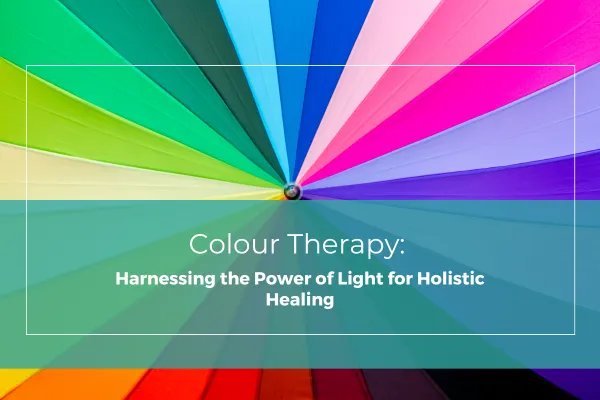
Colour Therapy: Harnessing the Power of Light for Holistic Healing
Table of Contents
The Science Behind Colour Therapy
The Psychological and Physical Benefits of Colour Therapy
1. Emotional Healing and Mood Enhancement
2. Stress Reduction and Relaxation
Incorporating Colour Therapy into Everyday Life
Common Colours and Their Healing Properties
Introduction
Colour therapy, or chromotherapy, is an ancient practice that is gaining renewed interest in modern holistic health. By leveraging the vibrational energy of colours, this gentle, non-invasive therapy aims to balance the body’s energy fields, reduce stress, and improve overall well-being. Imagine using the calming hues of blue to soothe anxiety or the invigorating energy of red to overcome fatigue—colour therapy makes this possible.
In this article, we’ll explore the science and philosophy behind colour therapy, its numerous benefits, and how it can be integrated into daily life or healing practices.
The Science Behind Colour Therapy
At its core, colour therapy is grounded in the concept that each colour has a specific wavelength and vibrational frequency. These frequencies interact with the body’s energy fields, influencing emotions, physical health, and spiritual well-being.
From a scientific perspective, light and colour affect us physiologically. For example:
Blue light exposure can lower blood pressure and heart rate, creating a calming effect.
Bright colours like yellow stimulate mental activity, while red increases circulation and energy.
Green, often associated with nature, has been shown to lower cortisol levels, the body’s stress hormone.
How Colour Therapy Works
Colour therapy can be delivered in various ways, depending on your needs and preferences:
Light Therapy Devices: Specially designed lamps or filters bathe the body or a specific area in coloured light. This is particularly effective for seasonal affective disorder (SAD) or conditions requiring targeted energy balance.
Meditation and Visualisation: During guided meditation, individuals focus on specific colours to align their energy or achieve emotional balance.
Environmental Design: Incorporating healing colours into your living or workspace—through paint, furniture, or decor—can create a supportive environment for well-being.
Crystal and Gemstone Use: Coloured crystals, such as amethyst (purple for relaxation) or carnelian (orange for vitality), can enhance the effects of colour therapy by combining light and tactile sensations.
The Psychological and Physical Benefits of Colour Therapy
1. Emotional Healing and Mood Enhancement
Colours have a direct impact on our emotions. For example:
Blue: Soothes anxiety and promotes calmness. Ideal for reducing stress or tension.
Yellow: Uplifts mood and stimulates creativity, making it a great choice for combating depression or mental fatigue.
Green: Restores a sense of balance and harmony, both emotionally and physically.
2. Stress Reduction and Relaxation
The soft hues of colours like violet and indigo are particularly effective at calming an overactive mind, reducing stress, and aiding in relaxation.
3. Chakra Balancing
In holistic practices, colours are associated with the body’s energy centers (chakras). For instance:
Red aligns with the root chakra for grounding.
Orange balances the sacral chakra, associated with emotions and creativity.
Blue harmonises the throat chakra, improving communication and self-expression.
4. Physical Health Benefits
Colour therapy isn’t limited to emotional health; it can also improve physical well-being. Red stimulates circulation, while green promotes tissue healing and cell regeneration.
5. Spiritual Growth
Colours like violet and indigo support deeper meditation and spiritual exploration, connecting individuals with their higher consciousness.
Incorporating Colour Therapy into Everyday Life
Colour therapy doesn’t require professional equipment to be effective. You can integrate its principles into your daily routine in simple ways:
Wear Colours That Reflect Your Intentions
Choose clothing in colours that match your mood or desired energy. Feeling low? Add a splash of bright yellow or orange to boost your spirits.Eat a Rainbow of Foods
Consuming a variety of colourful fruits and vegetables aligns your diet with the healing properties of colour.Design Your Space
Incorporate healing colours into your environment. For instance, a blue bedroom can promote calmness and better sleep, while a green office can enhance focus and balance.Light Therapy at Home
Use coloured light bulbs or LED strips to bathe your space in soothing or energising hues, depending on your needs.
Common Colours and Their Healing Properties

Who Can Benefit from Colour Therapy?
Colour therapy is suitable for all ages and can be adapted for various needs. It’s particularly effective for individuals experiencing:
Stress or anxiety.
Lack of focus or mental clarity.
Physical ailments like headaches or muscle tension.
Low energy or chronic fatigue.
Conclusion
Colour therapy offers a holistic, natural approach to well-being by harmonising the mind, body, and spirit. Whether you’re using light, meditation, or colourful surroundings, this ancient practice has something for everyone. Rediscover the power of colours and let their energy transform your life.
Illuminate your path to wellness with colour therapy! Book a session today or start integrating these healing hues into your daily life for balance and renewal.

